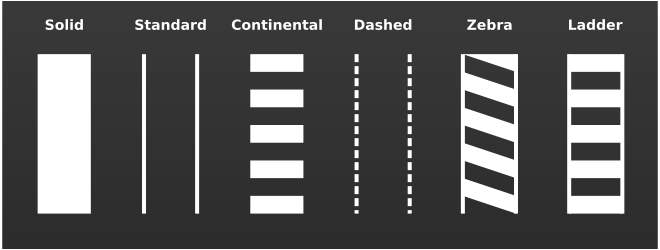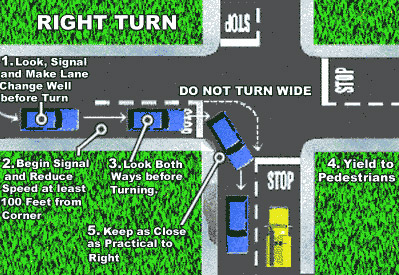2.5 Intersections USBE
- Due No due date
- Points 12
- Questions 12
- Time Limit None
- Allowed Attempts 3
Instructions
Watch and read everything on this page, then take the quiz.
4 way stops--who goes first intersections
How to know who gets to go -- who has the right of way when driving.mov
How to know who get to go first
How to make and Left and Right Turn.mp4
Uncontrolled intersections
You must earn at least 80% in order to pass this assignment.
If you earn less than 80%, please re-do the assignment.
Approaching and Entering Intersections
Approaching intersections
-
Search all corners for traffic controls, pavement markings, highway users, and areas of limited visibility.
-
Check mirrors for presence and actions of following traffic. Remember that over 30% of reported crashes are caused by rear-end collisions.
-
Make sure the driver is in the correct position and in the proper lane.
-
Be alert for traffic close to intended path.
-
Adjust speed to allow more time to search the area and to smoothly stop if necessary.
-
Remember, many people do not stop for signs and traffic signals.
-
If the driver has a restriction to the line of sight, the driver may need to change lane position and reduce your speed.
Entering intersections
-
Before entering a signalized intersection, look to the front, left and right for approaching vehicles and/or crossing pedestrians and bicyclists.
-
Whether a driver is first in line or in a line of vehicles, drivers should develop the habit of checking traffic and counting to three before moving. This brief wait provides some protection against drivers who fail to stop for the red signal or drivers ahead who suddenly brake to a stop.
-
Do not move into the intersection until there is space ahead in the next block.
-
Drivers may continue through the intersection if the traffic light is green or the intersection is clear.
-
If stopped, look left, right and left again before entering the intersection.
Stopping at Intersections
Drivers may have to stop at an intersection if there is a yellow or red traffic light, a stop sign, a yield sign, or something moving into your intended path of travel. As soon as the driver identifies a reason to stop at an intersection, begin braking. If there is a vehicle behind, drivers should top the brake pedal a few times so that the driver behind knows the front car is stopping.
-
Staggered stops - Staggered stops are designed to keep traffic staggered to allow for larger vehicles (tractor trailers and buses) to complete turns. They can be identified at intersections with multiple lanes where the left lane stop line appears a greater distance from the intersection than the right lane stop line.

-
Double stops - When approaching an intersection with a stop sign, stop line or crosswalk, it may be required or necessary to stop where visibility is totally or partially blocked. The driver must then pull ahead slightly, after stopping at the legal position behind the stop line, crosswalk, or sidewalk (unmarked crosswalk) and stop again where visibility is improved.
Where to Stop at Intersections
When required to stop because of a sign or signal, drivers must stop behind the stop line, crosswalk, sidewalk (unmarked crosswalk) or behind the stop sign or signal.
Crosswalks - Define the area where pedestrians may cross the roadway. If there is a crosswalk, the vehicle with a bumper or vehicle with wheels must stop with the front bumper or front wheels behind the nearest crosswalk line. Drivers must yield to pedestrians entering or in a crosswalk.

Stop line – White line found at most intersections. Sometimes there is a crosswalk and a stop line. Should there be a stop line and a crosswalk line the stop line must be obeyed first
Sidewalks - On streets that have sidewalks, but no painted crosswalks, remember that the crosswalks are still considered to be there (unmarked crosswalk). Handle these situations just as if the crosswalk were painted. Sometimes a driver will be leaving a driveway, alley, or building area such as a gas station or drive-in. It is required that the driver stop just as if there were a stop sign. The stop is made behind the sidewalk, and the driver must yield the right-of- way to all persons approaching from either side on the sidewalk and to all approaching traffic. When the way is clear, the driver may turn left or right, unless pavement markings or signs prohibit such a maneuver.

No pavement markings (curb line) - If there are no identifying pavement markings and the sign or traffic control device says stop, then the stop must be made with the front bumper or front wheel behind an imaginary curb line, which stretches from curb to curb closest to the driver. If there are no curbs present, then it must be imagined where they would be, and the stop completed at that imaginary curb line. Remember the vehicle must not slow or impede the flow of cross traffic.
Turning at Intersections
-
Approach the intersection by checking for the following: oncoming and cross traffic, other highway users, traffic control devices, roadway condition and areas of limited visibility.
-
Check mirrors for presence and actions of following traffic.
-
Signal intent to turn at the intersection 3 to 4 seconds in advance or 100 feet before the turn.
-
Position the vehicle for appropriate turn.
-
Steer into proper lane.
-
Tap brake pedal to alert following driver.
-
Adjust speed as necessary, stopping if required.
-
Recheck cross and oncoming traffic. Remember that 90 % of drivers do not stop for stop signs in residential areas.
-
Check mirrors.
-
Identify a safe time/space gap in cross traffic.
-
Look through turn to farthest possible point.
-
Steer into proper lane using hand to hand (push/pull/slide steering).
-
Adjust speed as appropriate.
-
Check mirrors for traffic to the rear.
Turning left
When turning left at an intersection, make sure you are in the correct lane if there are multiple lanes and pull into the intersection to be ready to turn left. Keep a traffic light in your upper vision if present. Before turning left across oncoming traffic, look for a safe gap in the traffic. Prior to turning search right, front, and left to be sure there are no vehicles or pedestrians in the travel path or approaching from either side. Before turning, search in the direction of oncoming traffic. Be sure you turn into the correct/legal lane. In some states the left turn on red is allowed. Check your state law.
Turning right
Before turning right, make sure that there is no traffic approaching from your left and no oncoming traffic turning left into your path. Do not begin turning without searching for approaching pedestrians. Where there is more than one right turn lane, exit and enter the corresponding lane and be alert for drivers crossing lanes while making the turn. Remember when turning right on red, drivers must first stop and yield right-of-way to any vehicles, bicycles or pedestrians in your path of travel.

Multi-lane Intersections
-
The procedures for crossing or joining traffic at higher speeds on multi-lane roadways are similar to those employed for basic intersection maneuvers; however, these maneuvers takes more time and are more dangerous.
-
Drivers must understand the increased risk of crossing multi-lane traffic at intersections controlled either by stop signs or traffic signals. While the procedures remain consistent, gap requirements increase substantially whether crossing or turning left or right.
-
Turning on multiple lanes, with drivers cutting across lanes, is another problem associated with traveling on multi-lane, higher speed roadways on which new drivers must learn to be alert.